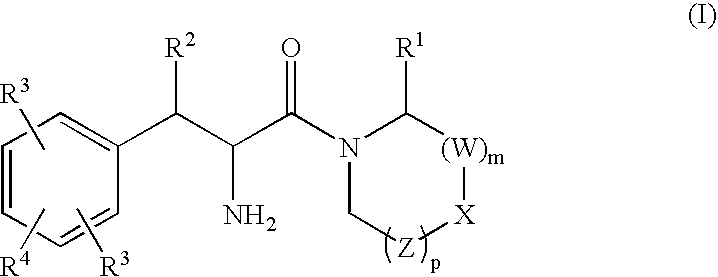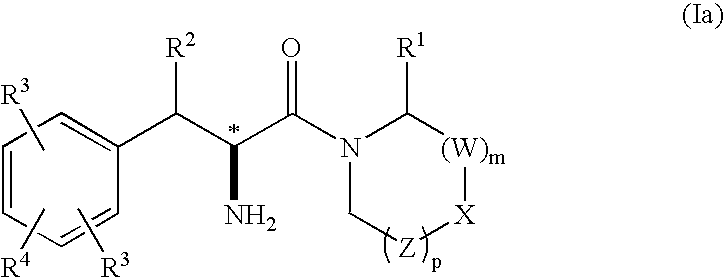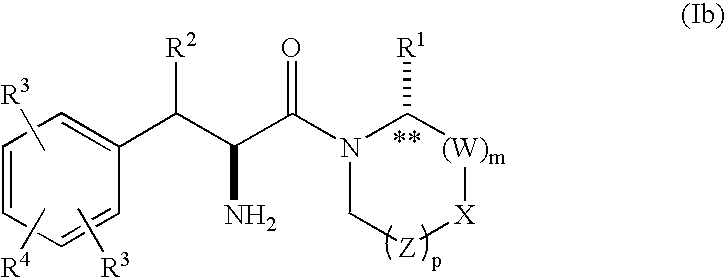Phenylalanine derivatives as dipeptidyl peptidase inhibitors for the treatment or prevention of diabetes
a technology of dipeptide inhibitors and phenylalanine derivatives, which is applied in the direction of biocide, drug composition, metabolic disorder, etc., can solve the problems of increased and premature morbidity and mortality, increased risk of macrovascular and microvascular complications in patients with type 2 diabetes mellitus, and increased risk of macrovascular and microvascular complications in patients
- Summary
- Abstract
- Description
- Claims
- Application Information
AI Technical Summary
Problems solved by technology
Method used
Image
Examples
example 1
[0416]
(3S)-1-[(2S,3S)-2-Amino-3-(4′-fluoro-1,1′-biphenyl-4-yl)-1-oxobutanyl]-3-fluoropyrrolidine, trifluoroacetic acid salt
Step A: (4R)-3-[(2E)-3-(4-Bromophenyl)prop-2-enoyl]-4-phenyl-1,3-oxazolidin-2-one
[0417]To a stirred solution of 4-bromocinnamic acid (5.79 g, 22.5 mmol) in anhydrous THF (250 mL) was added triethylamine (4.60 mL, 34.6 mmol) followed by trimethylacetyl chloride (3.54 mL, 24.7 mmol) at −78° C. The resultant suspension was stirred at −78° C. for 15 min, 0° C. for 1 h, at then −78° C. for 15 min before being transferred via cannula into a slurry of lithium 4(R)-4-phenyl-2-oxazolidinone at 0° C., which was prepared 15 min in advance at −78° C. by addition of n-butyllithium (19.1 mL, 30.5 mmol) to a solution of 4(R)-4-phenyl-2-oxazolidinone (5.0 g, 30.6 mmol) in anhydrous THF (150 mL) at −78° C. The resultant slurry was stirred at −78° C. for 1 h and room temperature for 12 h. The reaction was quenched with saturated aqueous ammonium chloride solution. The organic pha...
example 2
[0425]
(3S)-1-[(2S,3S)-2-Amino-3-(3′-carboxy-1,1′-biphenyl-4-yl)-1-oxobutanyl]-3-fluoropyrrolidine, trifluoroacetic acid salt
Step A: (3S)-1-[(2S,3S)-2-(tert-Butoxycarbonylamino)-3-(3′-benzyloxycarbonyl-1,1′-biphenyl-4-yl)-1-oxobutanyl]-3-fluoropyrrolidine
[0426]To a stirred solution of the product from Example 1, Step F (214.9 mg, 0.50 mmol) in 5 mL of toluene and 5 mL of ethanol was added 3-benzyloxycarbonylphenyl boronic acid (512.4 mg, 2.00 mmol), 1,1′-bis(diphenylphosphino)ferrocene palladium(II) chloride (81.7 mg, 0.100 mmol), and 2M aqueous sodium carbonate solution (1.25 mL, 2.50 mmol). The reaction was heated at 90° C. for 12 h before it was cooled to room temperature. The reaction mixture was filtered through a pad of silica gel. The solvent was removed in vacuo and the residue was purified by preparative TLC (silica, 50% ethyl acetate / hexanes) to afford the desired coupled product.
Step B: (3S)-1-[(2S,3S)-2-(tert-Butoxycarbonylamino)-3-(3′-carboxy-1′-biphenyl-4-yl)-1-oxobutan...
example 3
[0429]
(3S)-1-[(2S,3S)-2-Amino-3-[3′-(tetrazol-5-yl)-1,1′-biphenyl-4-yl]-1-oxobutanyl]-3-fluoropyrrolidine, trifluoroacetic acid salt
Step A: (3S)-1-[(2S,3S)-2-(tert-Butoxycarbonylamino)-3-(3′-cyano-1,1′-biphenyl-4-yl)-1-oxobutanyl]-3-fluoroppyrrolidine
[0430]To a stirred solution of the product from the Example 1, Step F (210.0 mg, 0.49 mmol) in 4 mL of toluene and 4 mL of ethanol was added 3-cyanophenyl boronic acid (275.6 mg, 1.87 mmol), 1,1′-bis(diphenylphosphino)ferrocene palladium(II) chloride (76.0 mg, 93.1 mmol), and 2M aqueous sodium carbonate solution (1.2 mL, 24.0 mmol). The reaction was heated at 90° C. for 12 h before it was cooled to room temperature. The reaction mixture was filtered through a pad of silica gel. The solvent was removed in vacuo and the residue was purified by preparative TLC (silica, 50% ethyl acetate / hexanes) to afford the desired coupled product.
Step B: (3S)-1-[(2S,3S)-2-[(tert-Butoxyl carbonyl)amino]-3-[3′-(tetrazol-5-yl)-1,1′-biphenyl-4-yl]-1-oxobuta...
PUM
| Property | Measurement | Unit |
|---|---|---|
| volume | aaaaa | aaaaa |
| emission wavelength | aaaaa | aaaaa |
| excitation wavelength | aaaaa | aaaaa |
Abstract
Description
Claims
Application Information
 Login to View More
Login to View More - R&D
- Intellectual Property
- Life Sciences
- Materials
- Tech Scout
- Unparalleled Data Quality
- Higher Quality Content
- 60% Fewer Hallucinations
Browse by: Latest US Patents, China's latest patents, Technical Efficacy Thesaurus, Application Domain, Technology Topic, Popular Technical Reports.
© 2025 PatSnap. All rights reserved.Legal|Privacy policy|Modern Slavery Act Transparency Statement|Sitemap|About US| Contact US: help@patsnap.com



